
Pseudopanax: planting, cultivation and care
Contents
Pseudopanax in a nutshell
- Pseudopanax is an unusual, distinctive tree, rarely cultivated
- It has fine, serrated foliage that changes shape as it matures!
- Depending on species, foliage shows beautiful variations in colour: purple, bronze, deep green, variegated with yellow…
- Ideal plant for a graphic, modern garden
- Rather frost-sensitive, it does best in a sheltered, wind-free spot in fertile, well-draining soil
A word from our Expert
Pseudopanax is an unusual tree, quite rare in cultivation, native to New Zealand. There are seven species, among them Pseudopanax ferox, with a truly original silhouette. In its juvenile form, which lasts many years, it develops a thin, very straight trunk from which linear, dentate leaves slope downwards, giving it a curious skeletal appearance. When mature, it becomes ramified and leaves broaden. Thus, in Pseudopanax ferox and P. crassifolius, leaves change in appearance with plant age. Leaves are often single and linear, but can also be divided into three or five leaflets, which are wider and rounded (Pseudopanax laetus, etc.). Leaves of Pseudopanax can also take on beautiful colours: bronze, purple, dark green… and there are also varieties with foliage variegated with yellow, making them very bright: Pseudopanax ‘Gecko Gold’ or ‘Goldsplash’.
Pseudopanax is a tree or bush of mild, humid climate. It is somewhat tender, suffering when temperatures fall below −5 to −7 °C. It thrives in humus-bearing, fertile, very well-drained, non-calcareous soil. It dislikes stagnant winter moisture, which can rot its roots. It can be grown in a pot to allow easy overwintering. Discover all our tips to grow this original plant, still too seldom seen in gardens!
Description and botany
Botanical data
- Latin name Pseudopanax sp.
- Family Araliaceae
- Common name Pseudopanax
- Flowering generally in summer
- Height up to 6-7 m
- Exposure sun or partial shade
- Soil type well-drained, humus-bearing, not lime-rich
- Hardiness between -5 and -7 °C
Pseudopanax are evergreen trees or bushes with very graphic habit and foliage. Most originate from New Zealand, where they grow mainly in forests and scrub. Some species are also found in Australia (Tasmania) and Chile. These are ancient, relatively primitive plants.
There are seven Pseudopanax species. The most cultivated is Pseudopanax ferox, a truly original and surprising tree, with a very straight trunk and linear leaves directed towards ground. Pseudopanax lessonii is also grown and has produced many horticultural varieties, each showing variations in leaf shape and colour: ‘Goldsplash’, ‘Dark Star’, ‘Goldfinger’, etc. Pseudopanax crassifolius is also in cultivation.
Pseudopanax belongs to family Araliaceae (which includes more than 1,500 species), such as ivy, Fatsia japonica, Tetrapanax, or Cussonia. This family also includes Aralia elata, sometimes called tree angelica, which has finely divided leaves and large white inflorescences.
Pseudopanax can reach 6–7 m in height, even up to 15 m for Pseudopanax crassifolius. They are fairly fast-growing trees. In juvenile form, which can last many years, Pseudopanax ferox and Pseudopanax crassifolius have a very upright habit, with a single, unramified trunk. They bring a lot of verticality to a border. As they mature (after about 15 years), these Pseudopanax begin to ramify, sending branches from top of trunk in different directions and eventually forming a small rounded canopy. Crown widens and ramifies. Likewise, over time, leaves disappear at base, leaving trunk naked. Trunk of Pseudopanax ferox can reach up to 25 cm in diameter when tree is adult.
By contrast, Pseudopanax arboreus, P. laetus and P. lessonii are already ramified when young, forming secondary branches early. They have a broader, bushier habit than other species.
In Pseudopanax ferox, leaves are very long and narrow, dentate on each side, making them resemble a saw. Its species name ferox refers to these teeth. Leaves are stiff and leathery, inclined downwards at an angle of 45° or less, producing a very original shape, forming like leading shoots upwards. This slightly evokes conifer spire shape. They give impression that bush grows upside down, head down. In Pseudopanax ferox leaves are grey-bronze, with a lighter central vein. Its uncommon foliage gives Pseudopanax an artificial appearance.

Pseudopanax ferox (photo Krzysztof Golik), and detail of its foliage / Pseudopanax crassifolius (photo Krzysztof Golik), and view of canopy of an adult specimen, which is ramified
Leaves of Pseudopanax lessonii are very different. They are usually divided into five leaflets, sometimes with a fairly wide lamina, as in variety ‘Gecko Gold’. Thus, when divided into large leaflets, leaves recall those of other Araliaceae, notably Fatsia japonica or Tetrapanax.
Leaves of Pseudopanax ferox have the peculiarity of changing shape as plant grows and ages. After 10–15 years, tree begins to form shorter, broader, dark green, non-dentate leaves. Juvenile leaf shape is in fact a defence mechanism against herbivores, deterring animals from eating them. When tree is older and leaves are higher, they are out of reach and can therefore widen!
Other species with a more developed lamina (P. lessonii, etc.) sometimes display variegated yellow foliage, as in Pseudopanax ‘Gecko Gold’ or Pseudopanax lessonii ‘Goldsplash’. Foliage can also be much darker, as in variety ‘Dark Star’.
Leaves of Pseudopanax are evergreen, remaining on tree in winter.

Leaves of Pseudopanax lessonii: species-type, varieties ‘Gold Splash’ and ‘Dark Star’ (photo Stervinou)
Pseudopanax usually flowers in summer, between July and September, but flowering is of limited ornamental interest. Flowers are small, with four to five petals, and generally arranged in terminal umbels. They can be green, cream-yellow or purplish. Umbels of Pseudopanax ferox measure between 5 and 10 cm in diameter.
Pseudopanax ferox is dioecious. Need young male plant and young female plant for fertilization and to hope for seeds.
After flowering, Pseudopanax produces (on female or hermaphrodite plants) small black–purplish fruits. They are rounded and measure between 3 and 8 mm in diameter.
Read also
Plant and grow southern plantsMain varieties of Pseudopanax
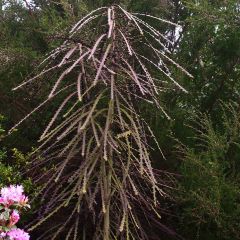
Pseudopanax ferox
- Flowering time July, August
- Height at maturity 7 m

Pseudopanax crassifolium
- Flowering time July, August
- Height at maturity 3,50 m

Pseudopanax Goldsplash
- Flowering time July, August
- Height at maturity 3 m
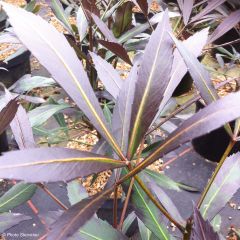
Pseudopanax lessonii Dark Star
- Flowering time July, August
- Height at maturity 3 m

Pseudopanax Gecko Gold
- Flowering time July, August
- Height at maturity 3 m
Discover other Pseudopanax
View all →Available in 1 sizes
Available in 1 sizes
Available in 1 sizes
Available in 1 sizes
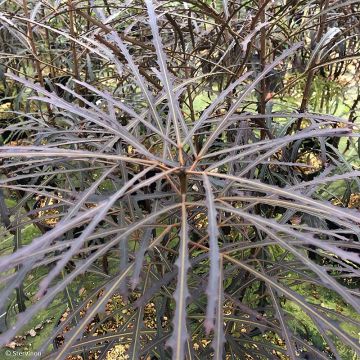
Available in 1 sizes
Available in 1 sizes
Available in 1 sizes
Available in 1 sizes
Available in 1 sizes
Planting
Where to plant?
Plant it in full sun or partial shade. Avoid scorching sun as well as very dense shade. Bush produces more leaves when in a sunny position. Plant Pseudopanax preferably sheltered from cold winds. It does not tolerate extreme temperatures, too cold in winter or too hot in summer. It prefers relatively mild, humid weather, such as in New Zealand.
Pseudopanax grows in fairly ordinary soils. It favours humus-bearing, fertile soils, but will still grow in poorer soils. We recommend planting it in a well-draining substrate. You can also plant on a mound or add coarse sand or gravel to the soil to improve drainage. Pseudopanax dislikes standing moisture in winter, which will make it more vulnerable to cold and can cause root rot. However, the soil must not be too dry either. Pseudopanax prefers rather acidic substrates and does not like calcareous soil.
Pseudopanax has the advantage of taking up very little space in the garden. It has a thin, very upright trunk, sparsely ramified. In addition, with its very fine leaves it does not really shade other plants.
If you live in an area with a mild climate, you can plant Pseudopanax in the ground. Otherwise, prefer planting in a pot. You can then bring it indoors in autumn and put it back outside in spring. It is also possible to grow it all year round under a temperate greenhouse.
When to plant?
We recommend planting Pseudopanax in spring, from May, once risk of frost has passed.
How to plant?
- Dig a large planting hole, about twice the size of the rootball.
- Replace some soil mixed with well-rotted compost and coarse sand, for drainage (you can also plant on a mound to help water run off).
- Remove Pseudopanax from its pot, loosen the rootball slightly and place it in the planting hole. The collar should be at the same level as it was in the pot.
- Backfill with substrate around it.
- Water generously.
- You can install staking to help keep the bush upright.
Continue to water during the weeks following planting.
You can also plant Pseudopanax in a large pot or container. This will allow you to bring it under cover easily in autumn to protect it from the cold.
- Choose a large pot with drainage holes in the bottom.
- Place a layer of clay pebbles in the bottom.
- Then add potting compost mixed with a little well-rotted compost and coarse sand.
- Position your Pseudopanax.
- Backfill with substrate around it to fill and hold it in place.
- Water generously.
- Place the pot in a bright spot sheltered from cold winds.
→ Learn more about growing Pseudopanax in a pot in our care sheet.
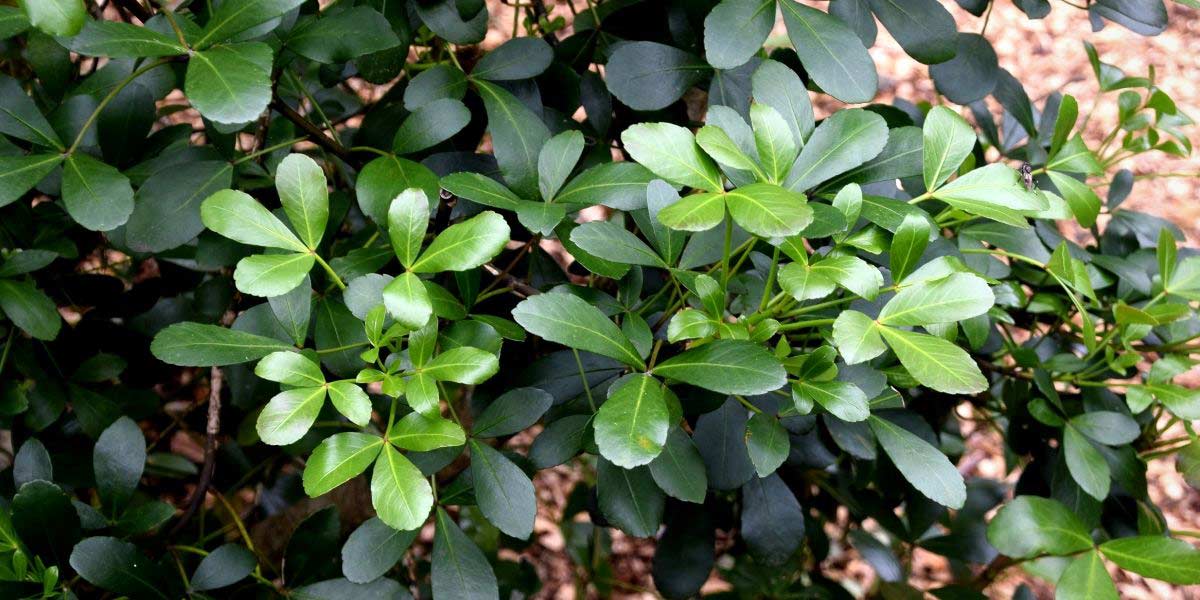
Pseudopanax lessonii (photo Krzysztof Golik)
Care
When grown in ground, Pseudopanax needs very little maintenance. It is a robust plant and not very susceptible to diseases or pests. Although relatively drought-tolerant, it is best to water it during first year after planting, and afterwards during prolonged drought. In a pot, waterings should be more frequent, on average one watering per week during growth period. You can reduce waterings in winter. When watering, prefer to use rainwater rather than tap water, which may be too hard.
If grown in ground, do not hesitate to add from time to time some well-rotted compost around its base and incorporate it superficially into soil by light forking. In a pot, you can apply liquid fertiliser about once a month during growth period. Reduce waterings and fertiliser applications in autumn–winter.
During first years, do not hesitate to install a stake to help Pseudopanax form a straight trunk. We do not recommend pruning Pseudopanax ferox and Pseudopanax crassifolius, which are not ramified; but you can prune species such as Pseudopanax lessonii if they take up too much space in a greenhouse or indoors.
You can protect Pseudopanax in winter with a winter fleece and a thick mulch at its base. If grown in a pot, put it outside in spring and bring it indoors in autumn to a frost-free shelter.
More information in our tutorial Pseudopanax: how to protect it from cold and overwinter it?
Propagation: sowing, propagation by cuttings
Pseudopanax can be propagated by sowing, propagation by cuttings or air layering. We recommend sowing.
Sowing
For sowing, use fresh seeds whenever possible as their germination rate is higher.
- Take a pot and fill it with a mix of potting compost and coarse sand.
- Firm down lightly.
- Sow seeds.
- Cover with a thin layer of substrate.
- Water.
- Place pot under cover in a bright position and, if possible, at a temperature of about 20°C
- Keep substrate slightly moist, but not waterlogged, until germination.
Propagation by cuttings
Pseudopanax can be propagated by taking semi-woody cuttings in early spring. However, as Pseudopanax ferox and P. crassifolius are not ramified in their juvenile phase, avoid taking cuttings from these species. Either wait until they are mature and take lateral branches, or reserve this propagation technique for other species.
→ See also : How to propagate Pseudopanax?
Pairing Pseudopanax in the garden
With its original silhouette, Pseudopanax ferox is ideal for creating a modern, graphic garden. It adds strong verticality, helping to structure a border. Create a garden with clean lines and subdued tones (green, bronze, purple, black, white, grey…). You can include ferns, horsetails, Alliums, Agapanthus, Japanese maples, bamboos… Also take advantage of the fine, light foliage of grasses. Pseudopanax can create a striking contrast when planted alongside lower-growing plants such as hostas, alchemillas, Hakonechloa macra, etc.
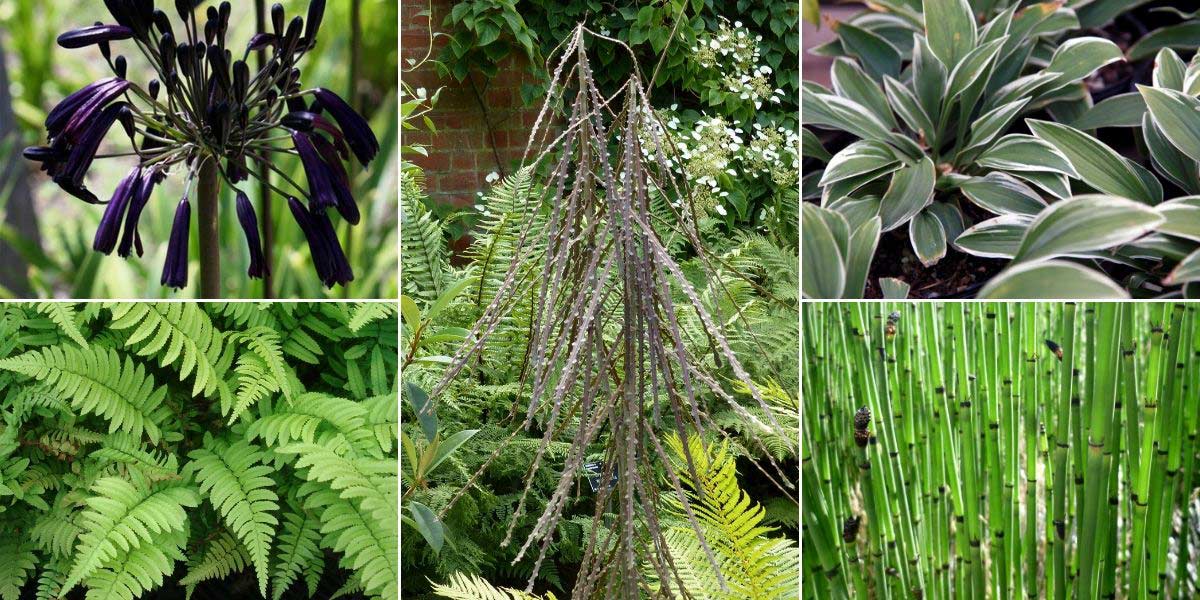
For a modern, graphic garden: Agapanthus ‘Black Magic’, Dryopteris cycadina, Pseudopanax ferox, Hosta ‘Allan P. McConnell’ (photo David J. Stang), Equisetum hyemale (photo Thayne Tuason)
Also don’t hesitate to pair Pseudopanax with other plants that have striking foliage! For example, you can plant Araucaria, Cotinus coggygria, Sambucus nigra, Grevillea… Consider Fatsia and Tetrapanax for their decorative foliage. Pseudopanax is also ideal for accompanying ancient, primitive plants such as cycads, tree ferns or horsetails. Also consider superb Wollemia nobilis, a very ancient conifer from Australia.
You can use Pseudopanax ‘Gecko Gold’ or ‘Goldsplash’ to create a beautiful golden scene, with other yellow foliage: Lysimachia nummularia ‘Aurea’, Carex elata ‘Aurea’, Agastache ‘Golden Jubilee’, etc. You can also achieve striking contrasts by planting a few dark-leaved plants: Ophiopogon planiscapus ‘Nigrescens’, Phormium ‘Dark Delight’, Heuchera ‘Obsidian’, Physocarpus ‘Midnight’…
For a garden of southern plants, notably including other plants from Australia, New Zealand and South Africa. Think Protea, Phormium, Watsonia, Agapanthus, Callistemon… You can also grow Restionaceae, those perennials with long stems that resemble rushes or grasses. For advice on cultivating these plants, see our Plant and grow southern plants advice sheet.
Virginie gives you other great ideas for pairing with Pseudopanax!
Useful resources
- Discover our range of Pseudopanax!
- Browse our care guide: Choosing a Pseudopanax
- Our selection of rare and collectors’ bushes
- To pair with Pseudopanax, discover our range of striking foliage bushes
Frequently asked questions
-
Should I prune Pseudopanax?
Pseudopanax ferox and Pseudopanax crassifolius, which at juvenile stage are not ramified and form a single, very straight trunk, may tempt you to prune them to force them to ramify, but we do not recommend this. Allow the bush to form its trunk without intervention. For other species, such as Pseudopanax lessonii, you can carry out occasional pruning if you deem it necessary, especially if cultivating under glass or indoors.
- Subscribe!
- Contents
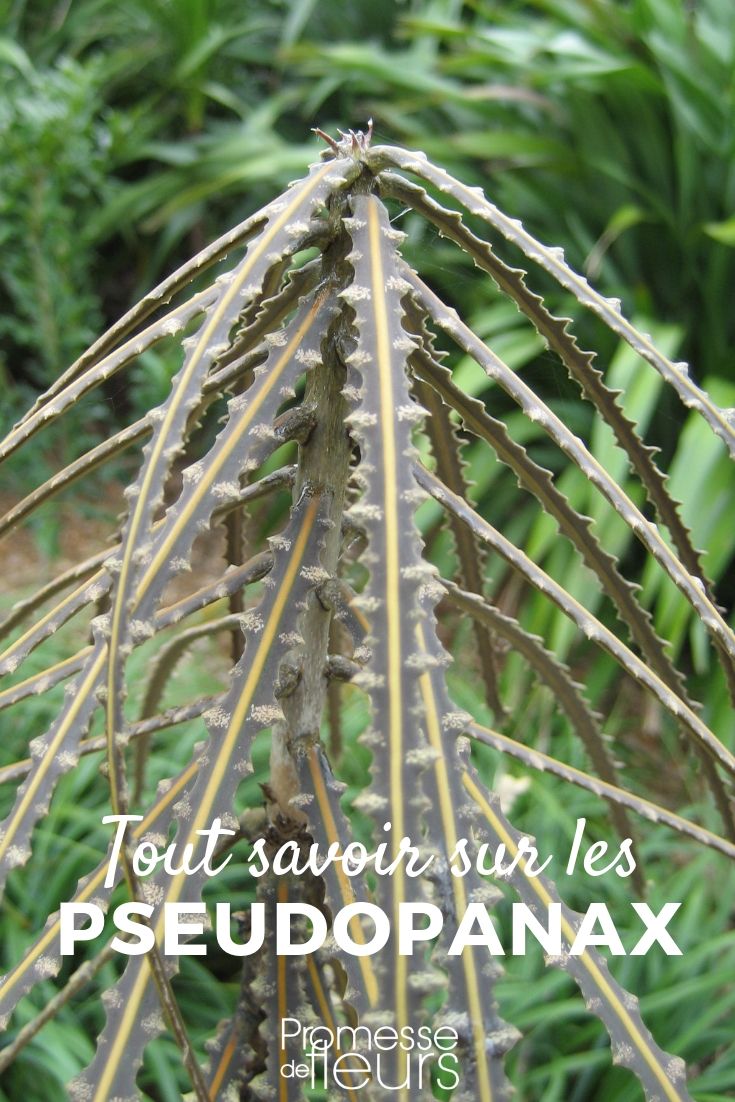

































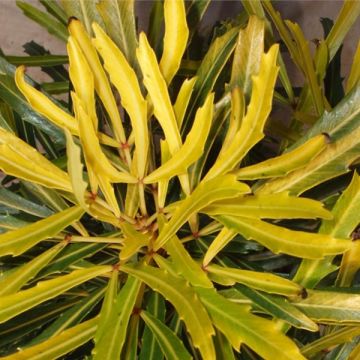





Comments